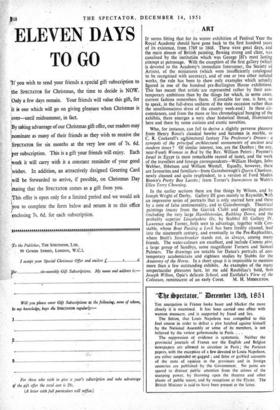ART
IT seems fitting that for its winter exhibition of Festival Year the Royal Academy should have gone back to the first hundred years of its existence, from 1769 to 1868. These were great days, and the main stream of British painting, flowing strong and clear, was canalised by the institution which was George III's most lasting attempt at patronage. With the exception of the first gallery (which is devoted to the Academy's immediate forerunner, the Society of Artists), of the miniatures (which were insufficiently catalogued to be recognised with accuracy), and of one or two other isolated works, the rule has been to show only examples which actually figured in one of the hundred pre-Burlington House exhibitions. This has meant that artists are represented rather by their con- temporary ambitions than by the things for which, in some cases, current fashion remembers them. (Constable for one, is here, so to speak, in the full-dress uniform of the state occasion rather than the unselfconscious dress of the country week-end.) In these cir- cumstances, and from the more or less chronological hanging of the exhibits, there emerges a very clear historical thread, illuminated here and there by some curious and exotic novelties.
Who, for instance, can fail to derive a slightly perverse pleasure from Henry Rossi's classical bowler and batsman in marble, or C. R. Cockerell's aLchitectural fantasy The Professor's Dream: a synopsis of the principal architectural monuments of ancient and modern times? Of similar interest, too, are the Danbys ; the coy, near-Fuseli Woman in Bed by the Rev. William Peters ; Poynter's Israel in Egypt (a most remarkable record of taste), and the work of the travellers and foreign correspondents—William Hodges, John Webber, Ibbetson and William Westall. Equally, however, there are favourites and familiars—from Gainsborough's Queen Charlotte, newly cleaned and quite resplendent, to a version of Ford Madox Brown's Pretty Baa Lambs ; from Turner's Snowstorm to Watts's Ellen Terry Choosing.
In the earlier sections there are fine things by Wilson, and by Joseph Wright of Derby. Gallery III goes mainly to Reynolds,With an impressive series of portraits that is only inarred here and there by a note of false sentimentality, and to Gainsborough. Theatrical paintings (many from the Garrick Club) and sporting pictures (including the very large Hambletoniatz, Rubbing Down, and the probably superior Lim;olnshire Ox, by Stubbs) fill Gallery IV. Lawrence and Turner, both seen to advantage, together with Con- stable, whose Boat Passing a Lock has been freshly cleaned, lead into the nineteenth century, and eventually to the Pre-Raphaelites, where Brett's Stonebreaker stands out, as always, among many friends. The water-colours are excellent, and include Cozens pere, a large group of Sandbys, some magnificent Turners and Samuel Palmers. The drawings are notable for Dance's portraits of con- temporary academicians and eighteen studies by Stubbs for the Anatomy of the Horse. In a short spaqe it is impossible to mention more than a few outstanding exhibits. As examples of the many unspectacular pleasures here, let me add Roubiliac's bold, firm Joseph Wilton, Opie's delicate School, and Eastlake's View of the Coliseum, reminiscent of an early Corot. M. H. MIDDLETON.






































 Previous page
Previous page